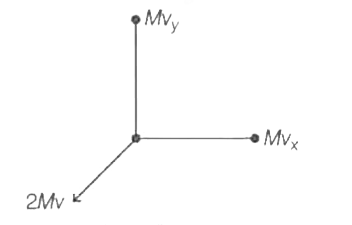A particle of mass 4 m explodes into three pieces of masses, m, m and 2 m. The equal masses move along X-axis and Y-axis with velocities 4 respectively. The magnitude of the velocity of the heavier mass isSolution in Telugu
The correct Answer is:C
Initial mass of particle = 4M
Initial velocity of particle = 0
After explosion into three pieces of masses M, M and 2M particle of equal masses move along X and Y axes with velocities 4m/s and 6m/s, respectively. So, according to law of conservation of momentum mass 2M particle will move in the direction shown in the figure.

Law of conservation of momentum, Momentum before collision = Momentum after collision.
So,
Topper's Solved these Questions
- AP EAMCET ENGINEERING ENTRANCE EXAM QUESTION PAPER 2017 (SOLVED)BOOK - TS EAMCET PREVIOUS YEAR PAPERSCHAPTER - AP EAMCET ENGINEERING ENTRANCE EXAM QUESTION PAPER 2017 (SOLVED)EXERCISE - Physics
40 Videos
- AP EAMCET SOLVED PAPER 2019BOOK - TS EAMCET PREVIOUS YEAR PAPERSCHAPTER - AP EAMCET SOLVED PAPER 2019EXERCISE - PHYSICS
40 Videos
Similar Questions
A monoatomic ideal gas through a cyclic process as shown in the figure . The efficiency of this process is

View SolutionTwo intervals of time are measured as Δt1=(2.00±0.02)sandΔt2(4.00±0.02)s. The value of √(Δt1)(Δt2) with correct significant figures and error is
View SolutionA particle of mass m moving with a velocity (3ˆi+2ˆj)ms−1 collides with another body of mass M and finally moves with velocity (−2ˆi+ˆj)ms−1. Then during the collision
View SolutionA particle of mass 4m explodes into three pieces of masses m,m and 2m The equal masses move along X-axis and Y-axis with velocities 4ms−1 and 6ms−1 respectively. The magnitude of the velocity of the heavier mass is
View SolutionA particle of mass 4 m explodes into three pieces of masses, m, m and 2 m. The equal masses move along X-axis and Y-axis with velocities 4ms−1and6ms−1 respectively. The magnitude of the velocity of the heavier mass is
View SolutionA body oa mass M at rest explodes into three pieces, two of which of mass (M/4) each are thrown- off in perpendicular directions with velocities of 6ms−1 and 8ms−1 respectively. The third piece will be thrown-off with a velocity of
View SolutionTwo bodies of masses 3 kg and 4 kg are moving along X axis. At a time t, the bodics are at a distance of 2 m and 3 m from the origin and has velocities of 2 ms^(-1) and-3 ms^(-1) . Calculate the position and velocity of centre of mass. What will be the total momentum of the system?
View Solutionmভরের একটি বস্তু x- অক্ষ বরাবর v বেগে গতিশীল অবস্থায়, 2v বেগে y-অক্ষ বরাবর গতিশীল 3m ভরের একটি বস্তুর সঙ্গে সংঘর্ষ ঘটাল এবং বস্তু দুটি যুক্ত হয়ে গেল | সংযুক্ত ভরটির অন্তিম বেগ হল-
View SolutionAn object located at the origin at rest has mass M. It explodes into three pieces having masses M/4, M/3 and 5M/12. The pieces move on a horizontal frictionless plane (call it x-y plane). The fragment with mass M/4 moves with velocity 5.0ms−1 at 37° to the x-axis. The fragment of mass M/3 moves wifh velocity 4.0ms−1 in the direction making an angle 45° to the x-axis.
a) What are the velocitity components of the third piece ?
b) What can be said about the motion of centre of mass of the system after tile explosion ?
View SolutionA mass m moving horizontally (along the X-axis) with velocity v collides and sticks to a mass of 3 m moving vertically upward (along the Y - axis) with velocity 2v. The final velocity of the combination is ……….
View SolutionA body of mass m=3.513kg is moving along the x-axis with a speed of 5.00ms−1. The magnitude of its momentum is recorded as
View SolutionA mass m moving horizontally (along the x-axis) with velocity v collides and stricks to a mass of 3 m moving vertically upward (along the y-axis) with velocity 2v. The final velocity of the combination is
View SolutionTwo bodies of masses m and 2m are moving along positive x and y axes respectively with equal speed 4ms−1. They collide at origin and stick together. The final velocity of combined mass is
View SolutionTwo bodies of masses m and 2m are moving along positive x and y axes respectively with equal speed 4 ms−1. They collide at origin and stick together. The final velocity of combined mass is
View SolutionA particle of mass m moving with a velocity (3ˆi+2ˆj)ms−1 collides with another body of mass M and finally moves with velocity (−2ˆi+ˆj)ms−1. Then during the collision
View SolutionTwo bodies of masses m and 2m are moving along positive x and y axes respectively with equal speed 4ms−1. They collide at origin and stick together. The final velocity of combined mass is
View Solution
